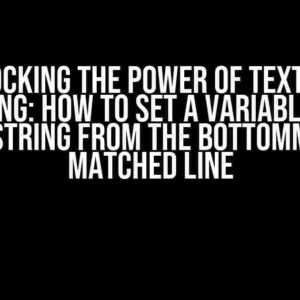As .NET developers, we’ve all been there – stuck in a sea of code, wondering why certain design decisions were made. One such enigma is the Shell.Items property being a getter-only BindableProperty. But fear not, dear reader, for in this article, we’ll dive deep into the world of Shell.Items and unravel the mysteries behind this peculiar design choice.
The Basics: What is Shell.Items?
Before we dive into the why, let’s quickly cover the what. Shell.Items is a property in Xamarin.Forms that represents the collection of items displayed in the shell. Think of it as the visual representation of your app’s navigation hierarchy. It’s essentially a list of ShellContent objects that are used to populate the shell’s UI.
public class Shell
{
public static readonly BindableProperty ItemsProperty = BindableProperty.Create("Items", typeof(IReadOnlyList<ShellContent>), typeof(Shell), null);
public IReadOnlyList<ShellContent> Items
{
get { return (IReadOnlyList<ShellContent>)GetValue(ItemsProperty); }
}
}
The Enigma: Why is Shell.Items a Getter-Only Property?
Now that we’ve established what Shell.Items is, let’s tackle the million-dollar question: why is it a getter-only property? At first glance, it might seem counterintuitive to restrict the Items property to only being readable. After all, wouldn’t it be more convenient to allow developers to set the Items property directly?
The answer lies in the realm of data binding and the underlying architecture of Xamarin.Forms. You see, Shell.Items is not just a simple property; it’s a BindableProperty, which means it’s designed to be used with data binding.
Data Binding 101
Data binding is a mechanism that enables automatic synchronization between the user interface and the underlying data model. In Xamarin.Forms, data binding is achieved through the use of BindableProperties, which are special properties that can be bound to a data source.
BindableProperties consist of two main components: the property itself and the BindableObject that owns the property. When a BindableObject is bound to a data source, the BindableObject will automatically update its properties to reflect changes in the data source.
The Role of Setter-Observable Properties
In traditional data binding scenarios, properties are typically implemented as setter-observable properties. This means that when the underlying data source changes, the property’s setter is called to update the property’s value. However, this approach has some limitations.
Imagine a scenario where the Shell.Items property is bound to a data source that contains a large list of items. If we were to set the Items property directly, the shell would need to re-render the entire list, which could lead to performance issues and UI lag.
Getter-Only Properties to the Rescue
This is where getter-only properties come into play. By making Shell.Items a getter-only property, Xamarin.Forms ensures that the shell only updates the UI when the underlying data source changes. This approach provides several benefits:
- Improved Performance**: By avoiding unnecessary updates, the shell can focus on rendering only the changes that are necessary, resulting in improved performance and a smoother user experience.
- Enhanced Data Integrity**: Getter-only properties ensure that the shell’s UI is always in sync with the underlying data source, reducing the risk of data inconsistencies.
- Simplified Data Binding**: With getter-only properties, data binding becomes easier to manage, as the shell takes care of updating the UI automatically.
Real-World Scenarios: When to Use Shell.Items
Now that we’ve covered the why behind Shell.Items being a getter-only property, let’s explore some real-world scenarios where this design choice shines:
Scenario 1: Dynamic Navigation
Imagine an app that needs to dynamically update its navigation menu based on user permissions. With a getter-only Shell.Items property, you can simply update the underlying data source, and the shell will automatically reflect the changes in the UI.
public class MyAppShell : Shell
{
public MyAppShell()
{
// Initialize the data source
var dataSource = new ObservableCollection<ShellContent>();
// Bind the data source to the Shell.Items property
Binding binding = new Binding("Items", dataSource);
this.SetBinding(Shell.ItemsProperty, binding);
// Update the data source dynamically
dataSource.Add(new ShellContent { Title = "New Item" });
}
}
Scenario 2: Data-Driven Navigation
In another scenario, you might want to drive the navigation menu from a database or a web service. With a getter-only Shell.Items property, you can easily bind the data source to the property, and the shell will take care of rendering the UI.
public class MyAppShell : Shell
{
public MyAppShell()
{
// Initialize the data source
var dataSource = new ObservableCollection<ShellContent>();
// Load data from the database or web service
dataSource.AddRange(LoadDataFromDatabase());
// Bind the data source to the Shell.Items property
Binding binding = new Binding("Items", dataSource);
this.SetBinding(Shell.ItemsProperty, binding);
}
private IEnumerable<ShellContent> LoadDataFromDatabase()
{
// Load data from the database or web service
// ...
}
}
Conclusion
In conclusion, the decision to make Shell.Items a getter-only BindableProperty is a deliberate design choice that enables efficient, data-driven navigation in Xamarin.Forms. By understanding the why behind this design, you’ll be better equipped to build robust, scalable, and maintainable apps that take full advantage of the Xamarin.Forms ecosystem.
So, the next time you encounter a getter-only property, remember: it’s not a limitation, but a powerful tool that can help you build faster, more efficient, and more maintainable apps.
| Scenario | Benefit |
|---|---|
| Dynamic Navigation | Easy updates to the navigation menu |
| Data-Driven Navigation | Simplified binding to data sources |
| Performance Optimization | Reduced UI lag and improved performance |
By embracing the power of getter-only BindableProperties, you’ll unlock new possibilities for building exceptional mobile apps that delight users and set your brand apart.
Frequently Asked Question
Let’s dive into the world of Xamarin.Forms and explore the mysteries of Bindable Properties!
What’s the point of making Shell.Items a getter only Bindable Property?
By making Shell.Items a getter-only Bindable Property, we ensure that it’s read-only and can’t be directly modified from the outside. This design choice provides a level of encapsulation, allowing the Shell class to maintain control over its internal state. It’s like putting a lock on the door, only allowing the Shell class to update its own items!
Isn’t it restrictive to only have a getter and no setter for Shell.Items?
Not necessarily! Having a getter-only property encourages a more intentional and controlled way of updating the Shell’s items. Instead of directly modifying the Items collection, you’ll need to use the provided APIs, like InsertItem or DeleteItem, which ensures that the Shell is notified and can react accordingly. It’s like having a personal assistant who helps you manage your tasks!
How does making Shell.Items a getter-only property impact data-binding?
Data-binding still works like a charm! Since Shell.Items is a Bindable Property, you can bind to it from your XAML or code-behind. When the Shell’s internal state changes, the Binder will notify the bound targets, ensuring that your UI stays up-to-date. It’s like having a reliable messenger who keeps your UI informed about the latest changes!
Can I still modify the Shell’s items collection in my code-behind?
While you can’t directly set the Shell.Items property, you can still modify the Shell’s items collection using the provided APIs, like Shell.Current.Navigation.InsertPageBefore or Shell.Current.Navigation.RemovePage. These methods allow you to make changes to the Shell’s internal state while maintaining the desired level of encapsulation. It’s like having a special permission to access the Shell’s internal workings!
What are the benefits of this design choice in the long run?
By making Shell.Items a getter-only Bindable Property, the Xamarin.Forms team has ensured a more maintainable, flexible, and scalable architecture. This design choice allows for easier future development, improved performance, and better support for advanced scenarios. It’s like building a solid foundation for a skyscraper – it might take extra effort upfront, but it pays off in the long run!



